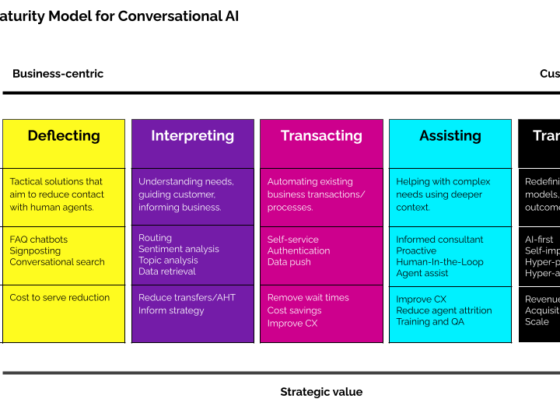Here’s why you’re thinking about conversational AI all wrong and why it’s more transformative than you think.

After reading this article from Zendesk, it dawned on me that the way some organisations are approaching conversational automation leaves a bit to be desired. Some are treating it like an incremental improvement to the customer experience, instead of a transformative, game-changing leap forward for both the customer and the business.
The potential hidden within conversational AI technology is transformative at a business level. It has the potential to automate transactions from end-to-end, disrupt business models and processes, and dramatically improve customer experience in a way that was impossible to achieve without recent advances in natural language understanding capability.
But most consultancies, technology providers and vendors are approaching it too tamely, tweaking the customer experience and not even touching the business process, instead of revolutionising both.
Most consultancies, tech providers and vendors are approaching conversational AI too tamely, tweaking CX and not even touching the business process, instead of revolutionising both. Click To TweetI’m not taking aim at Zendesk specifically here. That article is just one example of many articles, discussions and implementations I’ve seen that think nothing of mediocre conversational AI applications and overlook the true potential of the technology.
The benefits of conversational AI
Think about how miraculous conversational AI technology is for a second. Think about the fact that you can simply talk to a hockey puck in your kitchen and it not only understands you and can do things for you, but it can also talk back!
There’s way less friction than any other type of interface. It’s far quicker and is the most natively human interface we’ve ever had, or ever will have. However, all of that is nothing if the interface itself isn’t actually useful.
Being useful is the single most important value a conversational interface can have.
Being useful is the single most important value a conversational interface can have. Click To TweetThat sounds obvious, but judging by some of the applications out there at the moment, perhaps it isn’t.
And I’m not talking about having the facade of usefulness. I’m talking about actually solving a real need.
An example of a non-useful conversational AI
The example given in the Zendesk article showing how useful a chatbot can be is:
“When a customer asks a bot for help returning an item, the bot can direct them toward a piece of content that explains the company’s return policy.”
That’s actually a terrible experience. It reduces a pipeline of cutting edge artificial intelligence technology down to a keyword-based search box, which we’ve had for decades.
It’s a symptom that the creator didn’t understand the true user need behind the query. Rarely do customers want to know about your return policy in general. They want an answer to a specific query, like:
“Can I return {this item} if I decide I don’t like it?”
And they don’t want the policy thrown at them. That only solves part of the problem. It uses conversational AI to point the user in the right direction, then makes the user start a new search once they hit the policy page, sifting through a wall of irrelevant rubbish to dig out their answer.
How a useful conversational AI would handle it
A useful conversational AI would have understood the user need and provided a specific answer, as opposed to pointing the user in the general direction of their answer.
A more appropriate response to “Can I return {this item} if I decide I don’t like it?” is:
“Yes. For {that item}, you have 30 days to return it. Would you like to make a return right now?”
Here, the bot does the hard work of identifying the intent, pulling out the specific item, checking the return policy on that item, returning a clear and concise, conversational answer, then anticipates the user’s next move with a prompt that’s genuinely helpful and takes the user forward.
The challenge of creating a useful conversational AI
It’s not easy to create an interaction like the one above. Not always.
Firstly, conversational dialogue is different to typical written dialogue, and certainly different to legal dialogue found on return policy pages. That means that very rarely can you re-purpose your website content like-for-like and simply push that through a conversational interface. You need to change the way it’s written in the first place.
You need to make it more conversational, more concise and easier to either read or listen to (in the case of voice user interfaces).
Very rarely can you re-purpose your website content like-for-like and push it through a conversational interface. You need to change the way it's written in the first place. Click To TweetThat causes huge problems for some companies because it might prompt a rewrite of most of your content. Easier to just throw users over the wall. Give them the return policy page and let them fend for themselves, right?
Secondly, to answer a specific customer query means interrogating data. Data held within systems that you might not have access to. And to get access, it raises questions and causes challenges for other parts of the business. It means you need to have APIs for all of your line of business systems or, failing that, robotic process automation layered on top or maybe even new systems and processes entirely.
It brings stakeholders into conversations that otherwise wouldn’t have been involved, such as IT, data, security, policy, legal and more. Far easier to forget personalised responses and just send the user to the return policy page, right?
Lastly, the true potential of conversational AI is to completely automate end-to-end transactions. In this instance, that’s not only finding very specific, relevant pieces of information in the returns policy, it’s also being able to process a return from within the interface, without the user having to do anything else other than type or speak.
That causes more questions to be asked about your technical infrastructure because now, not only do you want to read data from systems, you also want to write data into systems. Now we’re in a discussion about identification and verification, business processes, procedures, people, staff, jobs, culture, silos.
How one line of dialogue can transform a business
Think about that response again:
“Yes. For {that item}, you have 30 days to return it. Would you like to make a return right now?”
Being able to offer that one line response and prompt in your chatbot can cause foundational questions to be asked of the business, its processes, its technology, its direction and its culture.
If that’s not transformative, I don’t know what is.
Far easier, like with most transformation projects, to tinker around the edges and make some incremental gains, no?
No.
Being able to offer that one line response and prompt in your chatbot can cause foundational questions to be asked of the business Click To TweetThe case for incremental steps
You might argue that having a chatbot that surfaces information from your website (or redirects people to pages on your website) is a step in the right direction. Perhaps you think that these incremental steps have a net positive impact on customer experience. If the end result is a user being able to navigate your website a little bit more seamlessly, then great, huh?
True, but in that instance, what do you need a chatbot for? Search boxes have been doing this job for generations.
What about if the company can’t create that kind of use case? What if they don’t have the API access or system integrations needed?
In that case, you should at the very least do more with the content you have. Break out that return policy into pieces and answer the user’s question directly in the conversation. Even if the response is a little generic, it’s better than a wall of copy on a web page. In this instance, the most important thing you can do is begin the conversations about systems, access and processes in earnest.
Reaching the potential of conversational AI
Just because something is hard, doesn’t mean it’s not worth doing. In fact, often the hardest things to do end up achieving the best results. If it was easy, everyone would be doing it with great success, which isn’t the case with conversational AI.
If it was easy, everyone would be doing it with great success, which isn’t the case with conversational AI. Click To TweetIt’s on us, then, the conversational AI experts, providers, advisors, consultancies, journalists and enthusiasts, to advise the industry better. To educate better. To push to realise the potential of conversational AI as a business transformation technology. Push for the potential of a radically improved customer experience, based on meeting real needs properly.
Brands, clients and anyone considering conversational AI need your help, even if they don’t realise it. And who else is in a better position to help them? You owe it to yourself, your client and the industry.




